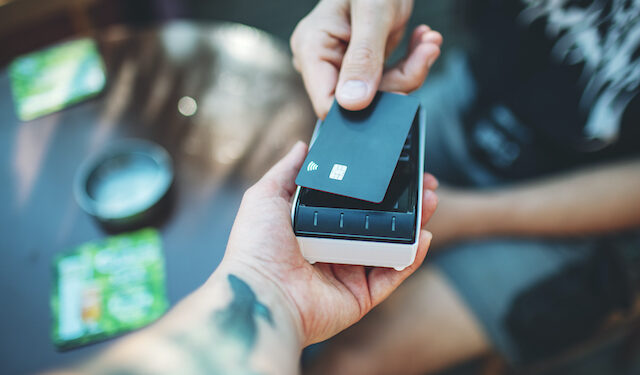In our increasingly cashless society, card payments are no longer a luxury—they’re a necessity, and businesses that fail to adapt risk losing out on valuable sales. Whether you run a café, a retail shop, or an online store, offering card payment options can significantly enhance your customer experience and boost your bottom line.
This comprehensive guide will walk you through everything you need to know about accepting card payments, from setting up your system to ensuring compliance with UK legal requirements.
- What do you need to take card payments?
- What card payment methods can you accept?
- How to set up, accept, and manage card payments
- 3 benefits of accepting card payments
- How can small businesses take payments?
- Best card readers for small businesses
What do you need to take card payments?
To start accepting card payments, you’ll need a few essential components:
1. Merchant account
A merchant account is a type of bank account that allows your business to accept card payments. It acts as an intermediary between your customer’s bank and your business bank account, ensuring smooth and secure transactions. If you operate online, you’ll also need an internet merchant account.
2. Merchant ID (MID)
Once you set up your merchant account, you’ll receive a unique 15-digit Merchant ID (MID). This number is crucial for tracking and managing your transactions, similar to a bank account number.
3. Payment provider
A payment provider (or payment processor) handles transactions between your business and your customers’ banks. Choosing the right provider is critical—look for one that offers reliable service, competitive fees, and robust customer support.
What card payment methods can you accept?
In-person payments
For face-to-face transactions, you’ll need a card machine terminal. These devices can process:
- Chip and PIN: Customers insert their card and enter a 4-digit PIN to authorise the transaction.
- Contactless payments: Customers tap their card or mobile device on the terminal for quick, hassle-free payments.
- Digital wallets: Payments via Apple Pay, Google Pay, or other mobile wallet apps.
Online payments
To accept online card payments, you’ll need a payment gateway integrated into your website. This portal allows customers to securely enter their card details for one-time or recurring payments.
Over-the-phone payments
For businesses that take orders or bookings over the phone, virtual terminals enable you to manually enter customer card details into a secure system. Always follow security best practices, such as verifying customer identity and using encrypted connections.
How to set up, accept, and manage card payments
1. Getting started
- Choose a payment provider: Research and compare providers based on fees, features, and support. Consider your current and future needs—for example, if you plan to expand online, choose a provider that supports both in-person and online payments.
- Set up your merchant account: Follow your provider’s instructions to create your account and obtain your Merchant ID.
- Select your hardware and software: For in-person payments, invest in a card machine or POS terminal. For online payments, integrate a payment gateway into your website.
2. Security and compliance
- PCI compliance: Adhere to the Payment Card Industry Data Security Standard (PCI DSS) to protect customer data. This includes encrypting card data, updating software regularly, and using secure payment gateways.
- Fraud prevention: Implement tools like 3D Secure for online transactions and ensure your card machines are tamper-proof.
3. Costs and fees
- Transaction fees: Typically range from 1.5% to 3.5% per transaction.
- Monthly fees: Some providers charge a monthly service fee.
- Setup fees: One-time costs for establishing your account.
Compare providers to find the best deal, and pay attention to minimum monthly fees if your transaction volume is low.
Read more: Looking for an affordable way to take card payments? Here are the cheapest card readers for small businesses.
3 benefits of accepting card payments
1. Improved cash flow
Card payments provide immediate access to funds, improving your business’s cash flow. Studies show that 83% of small businesses that accept cards see increased sales, and customers tend to spend more when using cards.
2. Customer convenience
Offering multiple payment options enhances the customer experience, leading to higher satisfaction and repeat business. Research shows that 58% of consumers are more likely to spend more at businesses that accept card payments.
3. Access to financial services
- Merchant cash advance (MCA): A flexible funding option based on future card sales.
- Transaction reports: Gain valuable insights into sales patterns and customer behaviour to optimise your business strategy.
How can small businesses take payments?
In-person payments
- Use a card machine or POS terminal for face-to-face transactions.
- Ensure your system supports contactless payments and digital wallets.
Online payments
- Integrate a payment gateway into your ecommerce platform.
- Offer recurring payment options for subscriptions or memberships.
Over-the-phone payments
- Use a virtual terminal to manually enter card details securely.
- Follow PCI compliance guidelines to protect customer data.
Best card readers for small businesses
Tide Card Reader
- Overview: Affordable, portable card reader for UK small businesses.
- Key features: No monthly fees, lifetime free 4G connectivity, PCI PTS-approved encryption.
- Transaction fees: Competitive rates; no fees for payments under £10 (first 3 months).
- Requirements: Tide business bank account.
- Extras: £200 cash reward for new customers processing £1,000 in payments.
Square Reader 2
- Overview: Compact, professional card reader for small businesses.
- Key features: Accepts chip and PIN, contactless, Apple Pay, and Google Pay; offline payments for 24 hours.
- Transaction fees: Flat fee of 1.75% per in-person transaction.
- Extras: Bluetooth connectivity, funds available as soon as the next day.
Takepayments
- Overview: Range of card machines for UK small businesses.
- Key features: Next-day settlement, 7-day UK-based customer support, personalised pricing plans.
- Transaction fees: Tailored based on turnover and machine choice.
- Extras: Options like A920 Pro (portable) and DX8000 (advanced receipt printing).
SumUp Air
- Overview: Affordable, portable card reader for small businesses.
- Key features: No monthly fees, 1.69% transaction fee, long battery life (500+ transactions per charge).
- Requirements: Smartphone connection via SumUp app.
- Extras: Optional charging station and SumUp Business Account for added functionality.
Zettle Reader 2
- Overview: Stylish, versatile card reader for in-store and on-the-go payments.
- Key features: No monthly fees, flat transaction fee, up to 48-hour standby battery life.
- Requirements: Smartphone or tablet connection via Zettle app.
- Extras: Optional Dock 2 for constant charging (£19–£39).
Read more: Ready to start taking card payments? Check out the best card readers for small businesses.
Final thoughts
Accepting card payments is no longer optional—it’s essential for staying competitive in today’s market. By offering multiple payment options, you can improve customer satisfaction, boost sales, and streamline your operations.
Whether you’re setting up a card machine, integrating a payment gateway, or exploring mobile payment apps, the key is to choose the right tools and providers for your business needs. With this guide, you’re well on your way to mastering the art of taking card payments and growing your small business.














